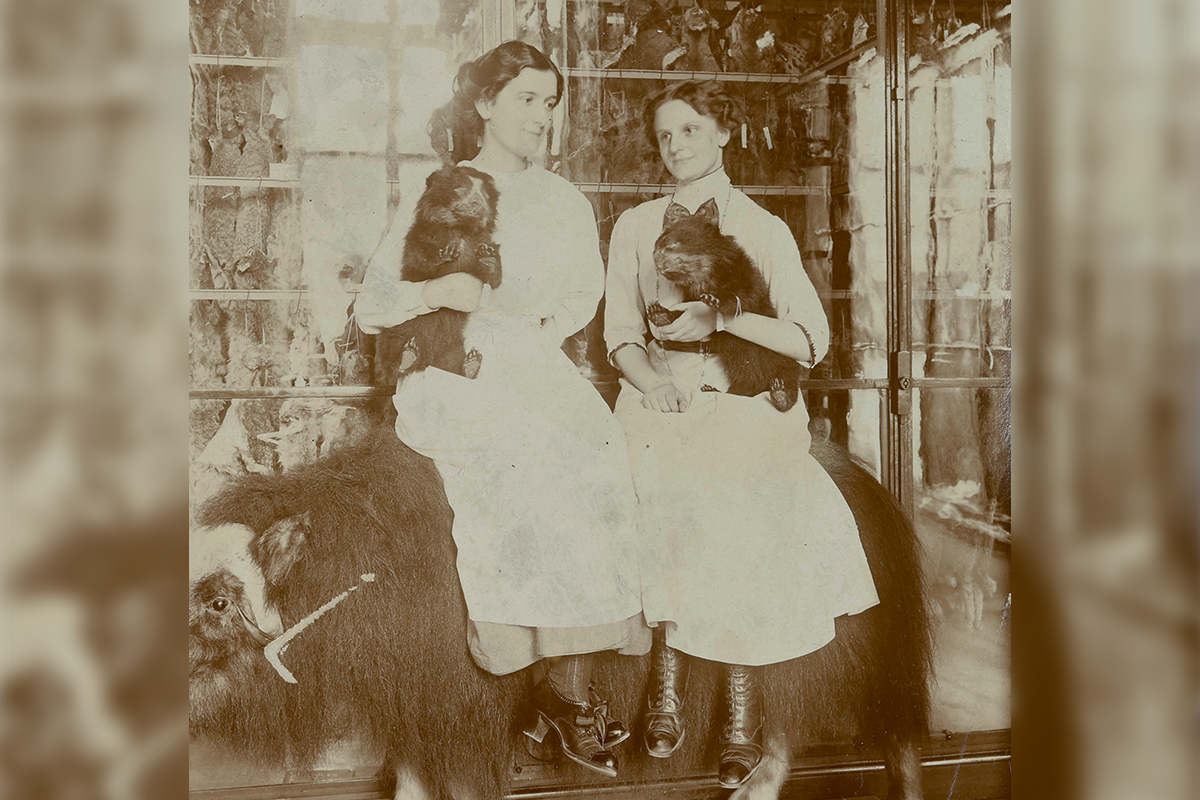They did exist! Searching for clues at the museum.
Anyone visiting the Mammals Collection at the Museum für Naturkunde will come across a specimen of a musk ox in the corridors with an enlargement of this historical photograph on the wall behind it. But who are the two smiling women photographed sitting on the animal with taxidermied bears in their arms?
Questions like this mark the beginning of the search for traces of women who have worked for the Museum für Naturkunde since its beginnings in the 19th century, be it in research, collections, exhibitions or administration. Compared to the numerous men who are honoured as researchers, collectors or patrons with statues, busts, oil paintings or on plaques on the building and in the exhibition, there is hardly any reference to the activities of women in the museum or in natural history in general.
In recent years, studies on women in natural history as a still underrepresented and marginalised group have increased. This research offers new insights into the history of science as well as the history of individual institutions and collections. This research exposes the natural history museum as a place where social ideas of gender roles are reproduced and consolidated. Additionally, it emphasises the contributions of individual women to science, which were ignored for a long time in natural history and defined as a male domain.
We founded the 'FIND – Women in Natural History' working group in 2024 to critically scrutinise the representation of gender in the museum by unearthing and visibly documenting the history(ies) of women who were associated with the Museum für Naturkunde. This involves both publicly known women, such as the biologist and science historian Ilse Jahn (1922 – 2010), as well as the many researchers, unskilled labourers, collection caretakers, scientific illustrators, taxidermists, librarians, archivists and photographers who have thus far remained invisible.
We have already identified more than 100 women who were associated with the museum. We now also know that Elsbeth Mundt (1892 – 1938), draughtswoman and first female technical employee of the mammal collection, can be seen on the right of the photograph. The woman on her left is Else Blum (1894, murdered in Auschwitz in 1943). Almost nothing is yet known about her work at the museum.
The FIND working group organises lectures and workshops (see Activities below). It meets at irregular intervals and is open to all interested colleagues and external parties.
FIND is a founding member of the international network WOMNH – Women in Natural History Museums and Collections.
Activities
-
4 November 2025:
"Hidden in Plain Sight — Identifying and Acknowledging Women in Natural History", talk given by Dr. Sabine von Mering (Museum für Naturkunde Berlin) at the SYMBIOSIS 2025 conference in Austria -
18 September 2025:
"Frauen in der Ornithologie – Vergessene Akteurinnen sichtbar machen" (Women in ornithology – Making forgotten female agents visible); Dr. Sabine von Mering, Dr. Sylke Frahnert (Museum für Naturkunde Berlin), Ulrike Jager & Dorit Visbeck-Liebers (Ocean Museum Germany, Stralsund): Poster presented at the Annual conference of the German Ornithological Society in Erfurt (1st poster prize) -
31 August 2025:
Dr. Sabine von Mering (Museum für Naturkunde Berlin) & Sophia Gräfe (HU Berlin, MfN Berlin), Podcast episode "The Invisibles" about »FIND – Frauen in der Naturkunde«, Podcast Beats & Bones -
08 July 2025:
„Women Botanists Hidden in Male-Dominated Networks: A Spotlight on the Silesian Botanist Käthe Hoffmann (1883–1960)“
Dr. Sabine von Mering (Museum für Naturkunde Berlin), talk as part of the WOMNH session „Paper, Pens and Specimens: Using Archival Media to Reclaim the Agency of Women in Natural History“ at the annual conference of the British Society for the History of Sciene in Cambridge - 11 June 2025:
„Secret Service: Women. Research. Senckenberg: Stories from the Archive“
Dr. Luisa Kapp (Senckenberg Forschungsinstitut und Naturmuseum Frankfurt), invited talk on the BMBF-Project „Secret Service: Frauen. Forschung. Senckenberg“ - 05 April 2025:
„From Acourtia to Zuckia – Plant genera named after women. The Women Genera Project or How we collaboratively created a dynamic Wikidata dataset“
Dr. Sabine von Mering (Museum für Naturkunde Berlin), invited keynote lecture during FemNetzCon 2025 in Neu-Ulm (in German) - 05 April 2025:
„Making hidden figures visible via Wikidata“
Dr. Sabine von Mering (Museum für Naturkunde Berlin), Wikidata Workshop during the FemNetzCon 2025 in Neu-Ulm (in German) - 10 March 2025:
1st WOMNH Seminar ‘Tracing Sarah Mary Fitton (1795-1874)’
Prof. Marie Mianowski (Grenoble Alpes University) presents her paper, with respondent Dr. Nessa Cronin (University of Galway). - 05 March 2025:
„Unsichtbar – vergessen – wiederentdeckt. Frauen in naturkundlichen Museen und Sammlungen“
Dr. Sabine von Mering (MfN Berlin), invited talk at the Natural History Museum Vienna - 27 January 2025:
„13 Frauen – Aus der Geschichte des NHM Wien“
Dr. Stefanie Jovanovic-Kruspel (Naturhistorisches Museum Wien), presentation of the NHM Vienna book project at the MfN Berlin -
10/11 December 2024:
Workshop ‘Tell me where the women are’
WOMNH Network Launching Event (co-organised by FIND) - Winter semester 2024/25:
Seminar „Frauen in der Naturkunde – Bildgeschichten aus dem Museumsarchiv“
Sophia Gräfe, HU Berlin and guest researcher at MfN Berlin, with guest seminars given by Dr. Sabine von Mering (MfN Berlin) and Dr. Stefanie Jovanovic-Kruspel (NHM Wien)
